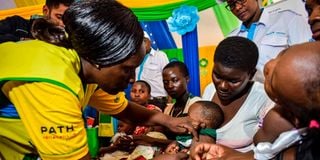Let’s pool local resources to fund the health sector

A health worker administers the new malaria vaccine to a child in Homa Bay County, western Kenya in September 2019.
What you need to know:
- Countries with low immunisation rate have suffered more deaths due to the lack of the common BCG (Bacillus Calmette−Guérin) vaccine.
- According to the National Academy of Sciences of the United States, several factors associated with BCG reduced Covid-19 deaths.
The Covid-19 pandemic is one of the most devastating in recent history. With more than 3.2 million deaths and counting, more emphasis need to be put on immunisation, which is critical in reducing the mortality rate.
Countries with low immunisation rate have suffered more deaths due to the lack of the common BCG (Bacillus Calmette−Guérin) vaccine. According to the National Academy of Sciences of the United States, several factors associated with BCG reduced Covid-19 deaths.
Among other factors, BCG vaccination of infants prevents disseminated childhood tuberculosis and halves the risk of pulmonary TB. With reduced TB globally, countries like Canada, France, Germany and Spain stopped mass vaccination programmes and now only vaccinate individuals who are at high risk of disease.
A nation cannot prosper if its population is unhealthy. The proposed budget for the Ministry of Health is about Sh111.7 billion in the financial year 2020/21. Key priority areas which the ministry is continuing to implement is support towards universal health coverage (UHC), which has been upscaled across the country following successful piloting.
Parliament ought to continue lobbying and supporting the programme to fruition as stressed by Naoko Yamamoto, the World Health Organization’s assistant director in charge of UHC, at a recent Parliamentarians for Peace (P4P) virtual meeting.
Critical interventions
Ms Yamamoto has been in the health sector for Japan in the past 30 years. She called for a high-level expert panel to fight the diseases afflicting the world and have crippled the world economy.
In Kenya, there is a notion that, despite healthcare being devolved, a lot of health resources still remain at the national level. Nothing can be farther from the truth. In the proposed 2020/21 budget, 50 per cent of the funds are from development partners, allocations as conditional grants to county governments and fees collected by Ministry of Health institutions, such as referral hospitals.
Health is still thinly funded at the national level, as manifested by the many funding gaps despite the sector being part of the ‘Big Four’ agenda. Some of these, which we are in constant engagements with, include the Linda Mama free maternity programme (Sh4.1 billion), health cover to the elderly and other vulnerable persons (Sh1.9 billion), equipping of hospitals (Sh6.2 billion), support for level five hospitals in the counties (Sh4.3 billion) and upscaling of UHC (Sh12.6 billion).
Others are vaccines, immunisation and family planning commodities (Sh2.1 billion), support to regional cancer centres (Sh1.3 billion), HIV, TB and malaria interventions through the Global Fund (Sh19.4 billion), support to national referral hospitals (Sh25.3 billion) and support to health research institutes and education facilities (Sh10.1 billion).
We should think about how to fully fund these critical interventions through our own resources rather than relying too much on support from outside.
Dr Mishra, the MP for Kesses, is a member of P4P. [email protected]





